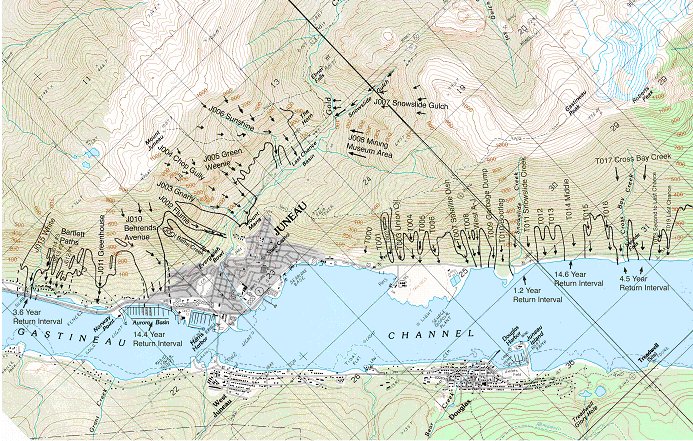Juneau Hazards
Living in Alaska means adapting to and preparing for the many natural hazards that exist in the northern latitudes. Juneau residents are exposed to a number of hazards as they go about their daily lives. Awareness is the first step in reducing vulnerability for individuals and households.
The following information will help residents take steps to prepare themselves for interactions with Juneau-area hazards. Click on each link to read more about each hazard and how you can prepare for it:
Avalanches
A snow avalanche is a swift, downhill-moving snow mass. The amount of damage is related to the size of the slide, type of avalanche, the composition and consistency of the material in the avalanche, the force and velocity of the flow, and the avalanche path. Avalanches usually occur on steep slopes, usually 35 to 60 degrees. Avalanches can occur outside the optimum slope angle range, but are not as common.
Avalanches take more lives nationwide than any other natural disaster event. Most avalanche deaths result from snow sport activities such as skiing, snowboarding, adn snowmobiling. It is common for the victim to trigger the fatal avalanche. Avalanches tend to occur repeatedly in localized areas and can shear trees, cover communities and transportation routes with packed snow and debris, destroy buildings, and cause severe personal injury or death.
Avalanches in Juneau have received much attention in recent years. Steep slopes, heavy, wet snow, and relatively warm temperatures combine every year to create conditions that are conducive to avalanches, especially from January to March. In the past 100 years, more than 70 buildings near downtown Juneau have been struck by avalanches. Large avalanche paths surround the city, especially near the Behrends and White subdivisions, and along Thane Road.
Click the map for a larger version:
What You Can Do
Backcountry travelers:
- All backcountry travelers should take, at minimum, a basic avalanche awareness course before traveling.
- Know your terrain: be aware of slope angles and other aspects of terrain that may indicate avalanche danger.
- Always carry a probe, beacon, and shovel when traveling in avalanche terrain.
- Avoid high-marking and other high-risk activities.
- Carry a cell phone and/or radio. Remember that cell phones and radios do not work well in mountainous terrain, though.
- If possible, tell someone where you are going and when to expect you back.
Residents:
- Be aware of where avalanche paths are.
- Pay attention to the weather; the level of avalanche danger changes every day.
- Carry a beacon whenever traveling in avalanche zones. For residents living in the highest hazard areas, this might mean wearing an avalanche beacon all the time. Remember that the beacon only works if you are actually wearing it!
- Consider reinforcing the structure of your home to withstand avalanche impact loads.
- Consider evacuating your home during times of high avalanche danger if you live in the path of a slide.
Large earthquakes are caused by the sudden release of accumulated stresses between crustal plates that move against each other on the earth’s surface. Earthquakes are of concern in Juneau because of the city’s proximity to large fault systems as well as the likelihood of landslides, avalanches and tsunamis resulting from a significant earthquake.
Although most of Alaska’s earthquakes occur in the Southcentral and Southwest regions, Southeast Alaska experiences earthquakes from the Queen Charlotte-Fairweather fault, which runs northwest to southeast in close proximity to Juneau. The Fairweather fault system has caused three recent moderate to large earthquakes: a magnitude 8.1 earthquake in 1949, a magnitude 7.9 event in 1958 that triggered the giant landslide-generated wave in Lituya Bay, and a magnitude 7.6 quake in 1972.
Much of the damage in large earthquakes in Alaska is caused by soil liquefaction. Juneau’s soils have not yet been assessed for liquefaction, but it is likely that floodplains, such as the Mendenhall Valley, are potentially at risk. Because of the steep slopes around Juneau, landslide-induced tsunamis are also possible if an earthquake triggers a large landslide.
What You Can Do
- Pick “safe places” in each room of your home. Injury statistics show that people who move during quakes are more likely to be injured. Also pick safe places in your office or school, or any other buildings you frequent.
- Practice drop, cover, and hold in each safe place. Practice these actions so that they become automatic response. Responding quickly and automatically may help protect you from injury.
- Secure items in your home that might fall, such as pictures or sculptures.
- Install strong latches or bolts on cabinets.
- Hang heavy items, such as pictures and mirrors, away from beds, couches, and anywhere people sit.
- Talk to your insurance agent about earthquake protection.
- Brace overhead light fixtures. During earthquakes, overhead light fixtures are the most common items to fall.
- Strap your water heater to wall studs. The water heater may be your best source of drinkable water following an earthquake. Protect it from damage and leaks.
- Repair any deep cracks in ceilings or foundations. Get expert advice if there are signs of structural defects. Earthquakes can turn cracks into ruptures and make smaller problems bigger.
- Check to see if your house is bolted to its foundation. Homes bolted to their foundations are less likely to be severely damaged during earthquakes. Homes that are not bolted can slide off their foundations and usually must be condemned.
- Consider having your building evaluated by a professional structural design engineer.
- Check propane and fuel tank fittings after earthquakes, and always have tools nearby for an emergency shutoff.
Living in Alaska makes residents familiar with severe weather of all types. In the Juneau area, common severe weather events include snow, high winds, dense fog, and coastal storms. Less common, but still occasionally observed are thunderstorms, hail, waterspouts, extreme cold, and blizzards. Extreme weather events in Juneau may be accompanied by secondary effects such as flooding, landslides, and avalanches. Still, severe weather rarely comes as a surprise in Alaska, so it’s certainly possible to protect your home and property from Alaskan weather.
Types of Severe Weather
The following severe weather events occur with some regularity in the Juneau area:
Heavy Snow
Heavy snow (6 inches or more in 12 hours or a foot or more in 24 hours) can immobilize a community by bringing transportation to a virtual halt. Air and ground transportation systems can be severely hampered and may even close until snow removal can be completed. Accumulations of snow can cause roofs to collapse and can topple trees and power lines. An accumulation of heavy snow can also damage light aircraft and can sink small boats. On mountainsides and slopes, heavy snow can lead to avalanches. A quick thaw after heavy snow can cause substantial flooding, especially along small streams and in urban areas. The cost of snow removal, repairing damages, and the loss of business can have severe economic impacts on cities and towns.
Injuries and deaths related to heavy snow usually occur as a result of vehicle accidents. Casualties also occur due to overexertion while shoveling snow and hypothermia caused by overexposure to cold weather.
Extreme cold
Extreme cold interferes with a community’s infrastructure. It causes fuel to congeal in storage tanks and supply lines, stopping electric generation. Extreme cold can cause water and sewer pipes to freeze and rupture, and can interfere with the operation of motor vehicles. If extreme cold conditions are combined with little or no snow cover, the ground’s frost depth can increase, affecting buried pipes.
What is considered an excessively cold temperature varies according to the normal climate of a region. The all time record low temperature in Juneau is -22 degrees Farenheit, so extreme cold is a rarity in the Juneau area. Still, wind chill temperatures as low as -50 degrees Farenheit are possible.
The greatest danger from extreme cold is to people. Prolonged exposure to the cold can cause forstbite or hypothermia and can become life-threatening.
Ice Storms
The term ice storm is used to describe occasions when ice accumulates to 1/4 inch or more on exposed surfaces such as trees, homes, power lines, and vehicles. Ice storms can be the most devastating of winter weather phenomena and often cause power outages, sometimes of extended length. Ice storms result from the accumulation of freezing rain, which is rain the becomes super cooled and freezes upon impact with cold surfaces.
 High Winds
High Winds
High winds are the most common extreme weather event in Southeast Alaska. In the downtown Juneau and Douglas areas, the mountainous terrain induces what are known locally as Taku winds. These winds occur an average of four times a year from October through April. Hurricane force wind gusts (72 mph or greater) occur roughly once every two years during these Taku wind events. Taku winds produce strong wind shear and turbulence that can affect the operation of air transportation in the area. Taku winds can also cause dangerous marine weather conditions.
Storm Surge 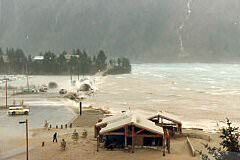
When high winds are combined with high tides and coastal storms, they can generate what is known as a storm surge. Storm surges are a leading cause of property damage in Alaska. Storm surges occur when the sea is driven inland above the high-tide level onto land that is normally dry. Often, heavy surf conditions driven by high winds accompany a storm surge, adding to the destructive force of the flooding waters. The conditions that cause coastal floods can cause significant shoreline erosion as the flood waters undercut roads and other structures. The picture at right shows the storm surge that occured on Thanksgiving Day in 1984. Because of their potential for heavy damage, storm surges can be the most dangerous and devastating aspect of coastal storms.
Dense Fog
Dense fog is fog that reduces visibilities to 1/4 mile or less for an hour or longer. Fog usually forms under clearing skies after several days of rain. Dense fog occurs in Juneau fairly often and can last up to a week at a time. Most dense fog events happen in November and December, and can interrupt aviation service as well as make driving and boating hazardous. Dense fog can also significantly affect air travel. The Juneau International Airport is adjacent to mud flats on the Gastineau Channel, an area favorable for fog formation.
Severe Weather Warnings
The National Weather Service Forecast Office in Juneau monitors for severe weather in Southeast Alaska. It coordinates weather forecasts and warnings with local emergency managers, the media, and other government agencies.
What You Can Do
Before and during a storm:
- Get a NOAA Weather Radio to monitor severe weather
- Keep cars and other vehicles fueled and in good repair, with a winter emergency kit in each.
- Store drinking water, first aid kits, canned food, manual can opener, radio, flashlight and extra batteries where you can get to them easily, even in the dark.
- Winterize your home, barn, shed, garage, or other structure that may provide shelter for your family, neighbors, livestock, or equipment. Install storm shutters on doors and windows, repair roof leaks, and check the structural ability of the roof to resist wind damage and sustain unusually heavy loads.
- If you must go outside during a severe storm, dress for the worst possible conditions.
- When driving or outdoors, carry with you enough spare clothing to protect you from the weather.
- Report downed power lines and broken gas lines immediately.
- Check on neighbors, especially those who might need help.
The leading cause of death in winter storms is transportation accidents. During the winter season, keep these tips in mind to stay safe:
- Keep your car fueled and in good repair.
- Install good winter tires.
- Be aware of road conditions. If you are concerned that you will not have the ability to drive safely on bad roads, get someone else to drive you or stay home if possible.
- Carry food, water, and extra clothing.
Landslide is the general term for any type of downward movement of earth material. Some landslides occur rapidly while others might take weeks or longer to develop. Landslides usually occur in steep areas, and can be caused by human activities as well as natural processes.Human activities that trigger landslides are usually associated with construction that removes material from the base, loads material at the top, or otherwise alters a slope. Changing drainage patterns, groundwater level or slope and surface water can cause landslides. Removal of vegetation from steep slopes can erode the integrity of the ground and lead to landslides as well as general erosion.
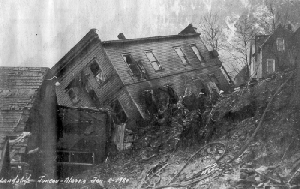 Landslides are a significant hazard in the Juneau area because of the steep slopes and heavy precipitation. Several very destructive landslides have occurred in Juneau’s history, especially in the area of Gastineau Avenue and South Franklin Street. Today, building codes and ordinances are in place to ensure that new construction will be able to withstand landslide impacts.
Landslides are a significant hazard in the Juneau area because of the steep slopes and heavy precipitation. Several very destructive landslides have occurred in Juneau’s history, especially in the area of Gastineau Avenue and South Franklin Street. Today, building codes and ordinances are in place to ensure that new construction will be able to withstand landslide impacts.
What You Can Do
- Do not remove vegetation from steep slopes. Cutting brush and trees can lead to destablization of soils and can cause landslides.
- Be aware of your home’s proximity to landslide-prone areas. Contact local officials, state geological surveys or departments of natural resources, and university departments of geology. If you find that this is the case, enlist the help of structural engineers when making changes to your home or landscaping to be sure that you do not compromise the stability of the slope.
- Watch the patterns of storm-water drainage on slopes near your home, and especially the places where runoff water converges.
- Plant ground cover on slopes and/or build retaining walls.
- In mudflow areas, build channels or deflection walls to direct the flow around buildings.
- Remember: If you build walls to divert debris flow onto a neighbor’s property, you could be liable for damages.
- Mudflow can be covered by flood insurance policies from the National Flood Insurance Program. Flood insurance can be purchased through a local insurance agency.
Tsunamis are a series of traveling ocean waves of extremely long length generated by disturbances associated primarily with earthquakes. In the deep ocean, their length from wave crest to waved crest may be a hundred miles or more but with a wave height of only a few feet or less. They cannot be felt aboard ships nor can they be seen from the air in the open ocean. In deep water, the waves may reach speeds exceeding 500 miles per hour.
A seiche is a similar wave that is confined in a partially or totally enclosed body of water. Seiches can also be caused by earthquakes and landslides, and can be particularly devastating because the wave may strike repeatedly as it rebounds back and forth across the body of water.
Tsunamis may seem unlikely in Juneau because Juneau is not exposed to the open ocean. However, Southeast Alaska has been the site of ten of Alaska’s historical tsunamis, including the tsunami with the highest wave height ever recorded. This famous tsunami, was induced by an earthquake-triggered landslide in Lituya Bay and reached a wave height of over 1700 feet.
Landslides and Tsunamis
Landslide-generated tsunamis occur not only in ocean bays, but in lakes as well. Tsunamis generated by landslides occur more in Alaska than in any other part of the United States. This kind of tsunami is possible in Juneau because of the presence of unstable soils and landslide-prone areas.
Earthquakes and Tsunamis
Not all earthquakes generate tsunamis. For a tsunami to be triggered, an earthquake must occur underneath or near the ocean and create movement of the sea floor. All oceanic regions of the world can experience tsunamis, but large, destructive tsunamis more frequently occur in the Pacific Ocean because of the many large earthquakes along the margins of the Pacific Ocean.
Tsunamis can also be caused by landslides or ice falls. When a large mass of earth slides into a body of water, it displaces a large amount of water and causes a tsunami. If the event occurs in a lake or channel, the water may slosh back and forth until the wave loses momentum – a phenomenon known as a seiche. Seiches were observed in Skagway during the Denali Fault earthquake of 2002.
Southeast Alaska has been the site of ten of Alaska’s historical tsunamis, including the tsunami with the highest wave height ever recorded. This famous tsunami was induced by a major landslide in Lituya Bay an dreached a wave height of over 1700 feet. Juneau’s history of landslides and unstable ground make landslide-induced tsunamis a particular concern.
The 1964 Good Friday Earthquake in Southcentral Alaska resulted in a tsunami that struck Southeast Alaska. Fortunately the series of waves traveled through the Panhandle during low tide and resulted in minimal damage. In Juneau, tsunami waves crested only four feet over the expected tide level. Juneau luckily escaped damage, but the event shows that distant-source tsunamis are indeed possible throughout the inner channels of Southeast Alaska.
What you can do
- A strong earthquake felt in a low-lying coastal area is a natural worning of possible immediate danger. Keep calm and quickly move to higher ground away from the earthquake.
- All large earthquakes do not cause tsunamis, but many do. If the quake is located near or directly under the ocean, the probablity of a tsunami increases. When you hear that an earthquake has occurred in the ocean or coastline regions, prepare for a tsunami emergency.
- Tsunamis can occur at any time, day or night. They can travel up rivers and streams that lead to the ocean.
- A tsunami is not a single wave, but a series of waves. Stay out of danger until an “ALL CLEAR” is issued by a competent authority.
- Approaching tsunamis are sometimes heralded by a noticeable rise or fall of coastal waters. This is nature’s tsunami warning and should be heeded.
- A small tsunami at one beach can be a giant a few miles away. Do not let the modest size of one make you lose respect for all.
- Sooner or later, tsunamis visit every coastline in the Pacific. All tsunamis-like hurricanes-are potentially dangerous even though they may not damage every coastline they strike.
- Never go down to the beach to watch for a tsunami! WHEN YOU CAN SEE THE WAVE YOU ARE TOO CLOSE TO ESCAPE. Tsunamis can move much faster than any person can run!
- During a tsunami emergency, your local emergency management office, police, fire and other emergency organizations will try to save your life. Give them your full cooperation.
- Homes and other buildings located in low lying coastal areas are not safe. Do not stay in such buildings if there is a tsunami warning.
- The upper floors of high, multi-story, reinforced concrete hotels can provide refuge if ther eis not time to quickly move inland or to higher ground.
- If you are on a boat or ship and there is time, move your vessel to deeper water (over 100 fathoms). If there is concurrent severe weather, it may be safer to leave the boat at the pier and move overland to higher ground.
- Damaging wave activity and unpredictable currents can affect harbor conditions for a period of time after the tsunami’s initial impact. Be sure conditions are safe before you return your boat or ship to the harbor.
- Stay tuned to your local radio, marine radio, NOAA Weather Radio, or television stations during a tsunami emergency – bulletins issud through your local emergency management office and National Weather Service offices can save your life.
It’s not surprising that Juneau has flood-prone areas; all that water has to go somewhere! Land around rivers is known as floodplain; the area that is covered by water when the river rises enough to overcome the boundaries of its banks. Flooding is a natural event that causes loss and damage when human development encroaches on floodplains.
Runoff flooding is the most common type of flood in the Juneau area. This type of flooding typically occurs due to weather systems that bring prolonged rainfall. Runoff floods can also occur as water is shed from mountainsides as ice and snow melts. Heavy rains can also saturate soils and lead to landslides (see previous toggle).
Juneau Areas At Risk of Flooding
Mendenhall River
The large Mendenhall River runs seven miles from Mendenhall Lake through the Mendenhall Valley. There is significant development in the Mendenhall Valley that could be affected by flood waters. Minor flood stage of the Mendenhall River is 12 feet, which was last reached in October of 1998.  Because of the flood control measures in place along the Mendenhall River drainage, it would take a flood stage of 14 feet or more to cause extensive flood problems along the floodplain of the Mendenhall River. When minor flood stage occurs on the Mendenhall, however, more extensive flooding will occur on Montana and Jordan Creeks.
Because of the flood control measures in place along the Mendenhall River drainage, it would take a flood stage of 14 feet or more to cause extensive flood problems along the floodplain of the Mendenhall River. When minor flood stage occurs on the Mendenhall, however, more extensive flooding will occur on Montana and Jordan Creeks.
High water on Mendenhall Lake will result in flooding on the edges of the lake, including the campground and Skater’s Cabin.
Montana Creek
Montana Creek, in the back of the Mendenhall Valley, experiences some form of flooding roughly every three years. This flooding is usually associated with heavy rain events in late summer or fall. Official flood stage (17 feet) on Montana Creek is usually reached by a combination of heavy rains and runoff from the melting snow pack. Montana Creek
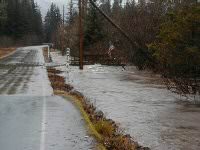 The low-lying back portion of Montana Creek Road sees minor flooding when the creek rises to its bank-full stage of 15 feet. When the creek reaches 16 feet, the Mendenhall Campground and Skater’s Cabin see minor flooding, water pools on the back portion of Montana Creek Road to a depth of approximately one inch, and nearby residents experience flooding in yards and driveways.
The low-lying back portion of Montana Creek Road sees minor flooding when the creek rises to its bank-full stage of 15 feet. When the creek reaches 16 feet, the Mendenhall Campground and Skater’s Cabin see minor flooding, water pools on the back portion of Montana Creek Road to a depth of approximately one inch, and nearby residents experience flooding in yards and driveways.
At official flood stage of 17 feet, flood waters cross Back Loop Road. Residents of parts of Montana Creek Road would experience flood damages to their homes and property.
The record high water mark on the Montana Creek gage near the Back Loop Road Bridge was 17. 3 feet, on October 20, 1998.
Jordan Creek
The headwaters of Jordan Creek, which is located in the southeast portion of the Mendenhall Valley, originate at the base of Thunder Mountain. A USGS river gage was recently installed about 200 yards upstream of the Trout Street Bridge. 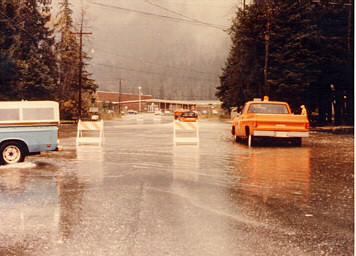 Based on comparisons, the new USGS gage shows minor flooding at 7.3 feet, moderate flooding at 8 feet, and major flooding at 9 feet. Moderate and worse flooding can affect the Jordan Creek subdivision area, as well as the businesses along the creek between Egan Drive and the airport.
Based on comparisons, the new USGS gage shows minor flooding at 7.3 feet, moderate flooding at 8 feet, and major flooding at 9 feet. Moderate and worse flooding can affect the Jordan Creek subdivision area, as well as the businesses along the creek between Egan Drive and the airport.
Jordan Creek flooded in 1972 (picture at right).
Lemon Creek
Immediately northwest of downtown Juneau is Lemon Creek, which flows out of the Tongass National Forest. Some development in the Lemon Creek area could be affected by moderate flooding. Downstream, the creek runs under the Egan Expressway.
Thane RoadSnowslide Creek, Cross Bay Creek, and Sheep Creek all usually contain very little water, but can flood Thane Road during heavy rains.
Flood Monitoring
The National Weather Service Forecast Office in Juneau monitors for flooding in Southeast Alaska. The staff coordinates hydrological forecasts and warnings with the River Forecast Center in Anchorage. Flood watches and warnings are issued when conditions warrant. The National Weather Service works with local emergency managers to ensure that the appropriate actions are taken once a flood watch or warning is disseminated.
Other Resources:
- Mendenhall Lake Gauge
- Mendenhall River Gauge
- Mendenhall Suicide Basin Gauge
- Montana Creek Gauge
- USGS Mendenhall River
What You Can Do
- Be aware of your home’s proximity to floodplains. If you live in a floodplain, evaluate your home and determine what you can do to reduce flood damages.
- Make sure that you have flood insurance for your home if you live in an area vulnerable to floods. Floods can damage everything in your home, and insurance makes it possible to recover some of your financial losses.
- During heavy rain, keep an eye on streams and rivers. Be prepared to head to higher ground if floodwaters threaten.
- Never drive or walk over flooded areas. Flood waters of only 6 inches can be powerful enough to sweep a human off his or her feet, and it only takes 18 inches of water to float a vehicle. Don’t take the risk – find another way to get to your destination!
- Do not let children play in flooded areas.
- Stay away from downed power lines.
- Monitor NOAA Weather Radio or your local radio stations for updates on the flood situation.
- Do not use fresh food that has come in contact with flood waters.
- Boil drinking water before using.
- After a flood, wells should be pumped out and the water tested for purity before drinking.
- Wash canned goods that come in contact with flood waters with soap and hot water.
- Do not handle live electrical equipment in wet areas; electrical equipment should be checked and dried before returning to service.
House fires are a leading cause of loss of life and property. Fires kill more people in the United States than all natural disasters combined. Because of the cold, dark, long winters in Alaska, it’s easy to forget that our space heaters, candles, and fireplaces can be very dangerous. Please take a moment to read through these “fire facts” from the United States Fire Administration.
- Cooking is the leading cause of home fires in the U.S. It is also the leading cause of home fire injuries. Cooking fires often result from unattended cooking and human error, rather than mechanical failure of stoves or ovens.
- Careless smoking is the leading cause of fire deaths. Smoke alarms and smolder-resistant bedding and upholstered furniture are significant fire deterrents.
- Arson is both the second leading cause of residential fires and residential fire deaths. In commercial properties, arson is the major cause of deaths, injuries and dollar loss.
- Heating is the third leading cause of residential fires. Heating fires are a larger problem in single family homes than in apartments. Unlike apartments, the heating systems in single family homes are often not professionally maintained.
- Candles are another significant cause of house fires.
What You Can Do
- Install and maintain smoke detectors in your home.
- Utilize fire safety while cooking, and have easy access to a fire extinguisher in your home.
- Make sure your dryer vents to the outside, rather than into a closed space such as a basement.
- Consider using artificial candles instead of real ones.
- If you do use candles, keep candle wicks trimmed, and be sure that there is nothing above, next to, or near that might ignite. It is best to keep a space of at least two feet between the candle and anything combustible.
- Never leave a burning candle in your home unattended, or even out of sight.
- Never leave candles or matches within the reach of children.
- Children should not be permitted to use the stove, matches, or fireplace without adult supervision.
- Never leave a space heater unattended.
- For more tips regarding space heater safety, follow this link – http://www.cpsc.gov/cpscpub/prerel/prhtml04/04054.html.
For more information, visit the Web site of the United States Fire Administration.
Additional hazards to be added in the future include:
- Transportation Accidents
- Hazardous Materials
- Volcanic Ash
- Erosion

